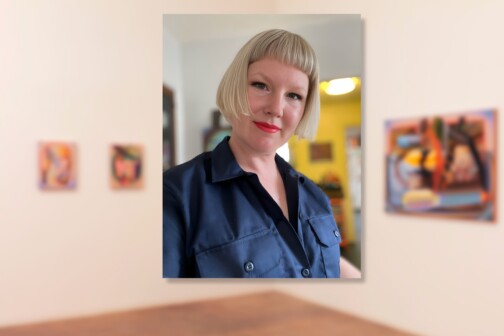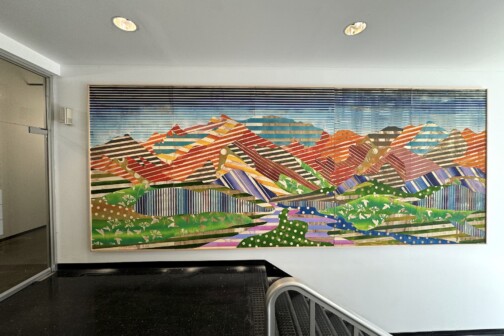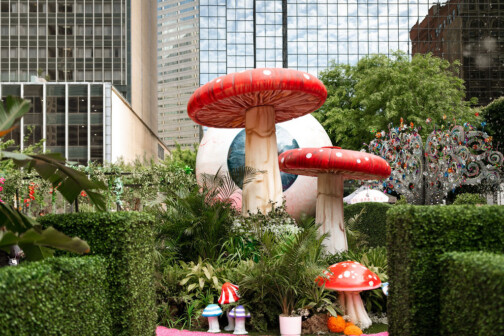Rania Matar’s portraits of young girls and women at Amon Carter Museum of American Art in Fort Worth envelop both subject and viewer with clear, tender sight. The photographer witnesses daughters as they grow, alongside their mothers and independently, with the exhibition In Her Image at the museum until June 17th.
The show has earned affectionate praise for its universal treatment of passing time and identity in the lives of women, for whom independence and familial love have a distinctly complex relationship. And the four series that form In Her Image will continue to develop with a new font of support: Matar just learned she’s one of 12 photographers to receive a 2018 Guggenheim Fellowship.
“It is validating on so many levels,” Matar says. “I look forward to the opportunity of expanding on the work I have been doing about womanhood and girlhood, growing up and growing old, about the series Becoming especially within the context of a new series that I have started titled SHE, which explores our physicality, our bodies, our texture in relationship to the physical tactile environment.”
Last week, Matar spoke by phone with Dallas photographer and filmmaker Christian Vasquez. Family is a constant subject of his work. Vasquez’s regard for the painterly traditions referenced in Matar’s portraiture— and his interest in making images accessible to and felt by all— proved them an ideal match in conversation.
How did you first embark on the idea to photograph these girls alone? Why was it important that they were alone?
The sequence I did the work in was actually A Girl and Her Room, and then L’Enfant Femme, and then Becoming and then mother and daughter [Unspoken Conversations]. The A Girl and Her Room project started because— my older kids are twins; I have a boy and a girl. And my daughter had been such a tomboy, and all of a sudden, she turned into this person I could hardly recognize. My early work was in the Middle East, in refugee camps and all that, and I was so ready to do something in the U.S.
So I started photographing my daughter when some friends would come. And I realized— it was so interesting— they were all performing for each other. I felt I couldn’t even recognize my daughter— I could recognize her in a mask.
So I just wanted to photograph each girl alone. I would go and photograph them in their bedrooms, and I was like ‘Oh my god, that’s my project.’ I was just amazed at the dynamic of being alone with them, versus with a group.
And to speak to that — they’re alone in their spaces, and I find it interesting how commercial imagery seems to loom in so many of the photographs. Can you speak to the way you seem to highlight that?
I was starting this work in the U.S. and then I realized— Oh my god, I was exactly those girls 25 or 30 years earlier.
The picture with the photographs of the rock stars, and with their friends— they were all there. It’s a way of starting to get a sense of how you relate to the outside world, from the privacy of your bedroom, in a way.
Like one of them, she’s surrounding herself with pictures of models. It’s interesting to see what’s interesting to them at that point.
I’m curious about how you create an atmosphere with your subject, particularly in the Unspoken Conversations series, with mothers and daughters. What is the tone like before you begin taking pictures? How do you develop a trust?
It’s almost the same with all the projects. Unspoken Conversations is a little trickier because I’m dealing with two people. I got good at relating to teenagers and the younger girls. With Unspoken Conversations there was another layer— many layers— of complexity. One of them being: there’s an older woman, and she’s more, I thought, aware of the camera than the girls are in some weird way, that’s more self-conscious I want to say. Some of the girls are self-conscious, too.
I didn’t want [the mothers] to think that I’m coming to make beautiful Christmas cards or holiday card pictures, and I would ask them to keep it simple, and that I want to make it natural.
Often I would go to wherever they are, whether they’re at the refugee camp or their home in the suburb, or whatever. It never was where they expected the photo to be taken. Often they would have the perfect living room, and eventually they get that’s not what I’m looking for— that I’m looking for the beautiful light …. something that has more expression and character and texture.
I give the women a lot of credit. Again, It becomes collaborative— I spend a lot of time there, I kind of observe them. I might give them a little bit of direction without being too heavy-handed.
I’m shooting medium format film, so every 10 pictures I have to change the film and I put down the camera. And whenever I put down the camera, all of the sudden you see something great because they both let down their guard and then I might say, “OK, can you please hold that?” And then I would pick up the camera again.
Do you think photographers today are losing a sense of the craft just by being immersed in the instant gratification of digital process? The photographers who only experience a digital relationship with photographs?
I don’t want to talk about photographers because everybody has their way of working but I realize that, for me — I shot A Girl and Her Room with digital, and I decided to go back to film.
At first I thought I was using the right medium for it. I never knew how dark or light it was [in their bedrooms] so it gave me that flexibility. And I really wanted the girls to get very comfortable so I would shoot more rather than less. But I also realized I like my own process much better with film. It slows me down a bit, it makes me more deliberate.
I like not editing right away and not seeing the images right away. I like the people I’m photographing not to be able to keep asking me to look at the work as I’m shooting, because I find that very disruptive and they become more self-conscious.
One woman during a shoot— all she started focusing on was like, “Oh God, look at my neck.” It ruined the photo shoot for me because I [became so] aware of her neck.
I like my film process more, personally. I love the fact that I feel like I’m working on the images. Things like Instagram and all these platforms— I use Instagram pretty heavily. But I’m afraid sometimes that It makes people numb to photography. I have mixed feelings about all of that.
Yes. I share that concern. As a photographer, it feels like it’s harder for people to discern what is a “good” image from a “not-good” image — commercial images that are all dressed up become “good” in the way we “like” things on Instagram.
Exactly. And now it’s becoming a way to connect all the photographers to curators. I don’t know where’s that’s going.
So often when I take iPhone shots during the shoots I may post those and say that it’s an iPhone shot, I’m trying to keep it separate but when I see the real thing, and it’s so much better, I wish I didn’t post the iPhone shot.
Could you talk about the importance of shaping the photographs in the darkroom or digitally and creating a good print? What is the importance of a good print?
That’s so important. I teach a class at MassArt [Massachusetts College of Art and Design] and our final presentation is our prints on the wall.
I think it’s so important to look at the craft. I do scan my negatives, I make high resolution scans on an Imacon scanner so the files are large. And It’s important to me to have beautiful prints. At the end of the whole process — I feel like I want to make it art, and I want it to be as good as I can possibly present it.
I don’t overwork my images, but I do whatever I did in my dark room, if that makes sense. I have a lot, I don’t print everything. The best work is what gets printed and presented. And I like the prints to be large when possible. With film, and medium format— I love the texture and the faces and the crane, it makes it more— there’s a tactility and a physicality.
What do you think a print can do that a digital image just can’t?
A print makes the photo unique. It makes you stop. You can step close. I do use a digital process to edit my work, and I don’t want to take away how important that it to my work flow.
When you’re looking at a print, it has a presence that a file on a computer doesn’t have. I want to say it becomes more important or unique or precious, in a good way. Does that make sense?
Certainly. What’s so striking about the exhibit is that you feel like you’re in a hall with these women. Their presence is undeniable, in the exhibit.
Yeah, and the size! You can see the details of the hands and the wrinkles on the face, in one of the photos you can see what video she’s watching. Some of the stuff I didn’t even notice until it was on the wall, in that size.
The Amon Carter possesses the Avedon In Texas: Selections From The American West series, which shares qualities found in your work, in the presented scale and in the direct relationship between subject and camera— and they had it on exhibit last year in the same space that your exhibit is in.
I heard that!
The parallels between the works are really fascinating and are enhanced by the shared space. It’s not unlikely that many viewers will find themselves pondering the conversations in the work. It’s wonderful. I have one more question. If it’s not true, then it’s not true, but I imagine you carry these young girls and women in your mind, you know, because you spend so much time with them in the shoot, and in editing. I’m wondering if, as time passes, do you carry them with you in your head, like characters in a movie?
The one that’s in the show, with the older woman and her daughter— Brigitte and Huguette. The moment of the picture was so poignant and stays with me. The mother is an artist who’s no longer famous who’s no longer painting. She’s very famous in Lebanon. And as I’m photographing her she was wearing that smock and I don’t know, I was just faced with old age, with her aging, and all of that, and it made me cry.

When I started crying they both started crying so I put my camera down out of respect and the mother who looked like she wasn’t quite present at that point told me, “You’re an artist. Emotions are important. Don’t stop.”
That stays with me forever. That actual image is so special to me because of the moment I shared with them. And the photograph used to bother the daughter but now she knows her mother wanted that image to be made, and now she likes the photograph.
Rania Matar speaks at the Amon Carter April 28 at 10:30 a.m.
Get the FrontRow Newsletter
Author






